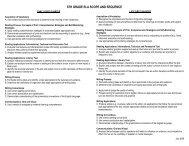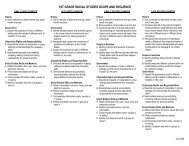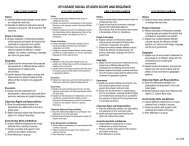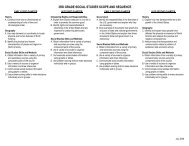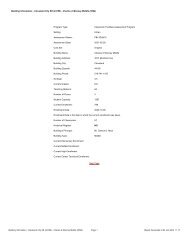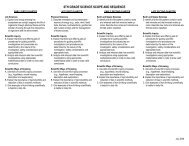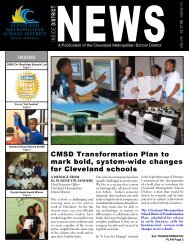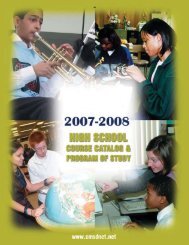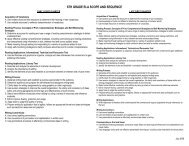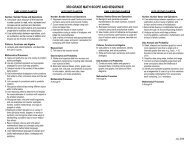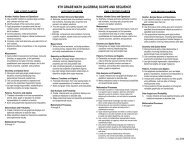6TH GRADE SOCIAL STUDIES SCOPE AND SEQUENCE
6TH GRADE SOCIAL STUDIES SCOPE AND SEQUENCE
6TH GRADE SOCIAL STUDIES SCOPE AND SEQUENCE
You also want an ePaper? Increase the reach of your titles
YUMPU automatically turns print PDFs into web optimized ePapers that Google loves.
EARLY FIRST QUARTER<br />
<strong>6TH</strong> <strong>GRADE</strong> <strong>SOCIAL</strong> <strong>STUDIES</strong> <strong>SCOPE</strong> <strong>AND</strong> <strong>SEQUENCE</strong><br />
LATE FIRST QUARTER<br />
EARLY SECOND QUARTER<br />
LATE SECOND QUARTER<br />
History<br />
A. Interpret relationships between events shown<br />
on multiple-tier time lines.<br />
B. Describe the political and social<br />
characteristics of early civilizations and their<br />
enduring impact on later civilizations.<br />
Geography<br />
A. Identify on a map the location of major<br />
physical and human features of each<br />
continent.<br />
Government<br />
A. Explain why people institute governments,<br />
how they influence governments, and how<br />
governments interact with each other.<br />
Social Studies Skills and Methods<br />
A. Analyze different perspectives on a topic<br />
obtained from a variety of sources.<br />
B. Organize historical information in text or<br />
graphic format and analyze the information in<br />
order to draw conclusions.<br />
C. Present a position and support it with<br />
evidence and citation of sources.<br />
D. Work effectively in a group.<br />
People in Societies<br />
A. Compare cultural practices, products and<br />
perspectives of past civilizations in order to<br />
understand commonality and diversity of<br />
cultures.<br />
Economics<br />
A. Explain how the endowment and<br />
development of productive resources affect<br />
economic decisions and global interactions.<br />
Citizenship Rights and Responsibilities<br />
A. Show the relationship between civic<br />
participation and attainment of civic and<br />
public goals.<br />
Social Studies Skills and Methods<br />
A. Analyze different perspectives on a topic<br />
obtained from a variety of sources.<br />
B. Organize historical information in text or<br />
graphic format and analyze the information<br />
in order to draw conclusions.<br />
C. Present a position and support it with<br />
evidence and citation of sources.<br />
D. Work effectively in a group.<br />
History<br />
B. Describe the political and social<br />
characteristics of early civilizations and their<br />
enduring impact on later civilizations.<br />
Geography<br />
B. Define and identify regions using human and<br />
physical characteristics.<br />
Economics<br />
A. Explain how the endowment and<br />
development of productive resources affect<br />
economic decisions and global interactions.<br />
Government<br />
C. Compare the defining characteristics of<br />
democracies, monarchies and dictatorships.<br />
Citizenship Rights and Responsibilities<br />
B. Identify historical origins that influenced the<br />
rights U.S. citizens have today.<br />
Social Studies Skills and Methods<br />
A. Analyze different perspectives on a topic<br />
obtained from a variety of sources.<br />
B. Organize historical information in text or<br />
graphic format and analyze the information<br />
in order to draw conclusions.<br />
C. Present a position and support it with<br />
evidence and citation of sources.<br />
D. Work effectively in a group.<br />
People in Societies<br />
B. Analyze examples of interactions between<br />
cultural groups and explain the factors that<br />
contribute to cooperation and conflict.<br />
Economics<br />
B. Explain why trade occurs and how historical<br />
patterns of trade have contributed to global<br />
interdependence.<br />
Social Studies Skills and Methods<br />
A. Analyze different perspectives on a topic<br />
obtained from a variety of sources.<br />
B. Organize historical information in text or<br />
graphic format and analyze the information in<br />
order to draw conclusions.<br />
C. Present a position and support it with<br />
evidence and citation of sources.<br />
D. Work effectively in a group.<br />
July 2008
EARLY THIRD QUARTER<br />
<strong>6TH</strong> <strong>GRADE</strong> <strong>SOCIAL</strong> <strong>STUDIES</strong> <strong>SCOPE</strong> <strong>AND</strong> <strong>SEQUENCE</strong><br />
LATE THIRD QUARTER<br />
EARLY FOURTH QUARTER<br />
LATE FOURTH QUARTER<br />
History<br />
D. Describe the effects of interactions among<br />
civilizations during the 14th through the 18th<br />
centuries.<br />
History<br />
D. Describe the effects of interactions among<br />
civilizations during the 14th through the 18th<br />
centuries.<br />
History<br />
D. Describe the effects of interactions among<br />
civilizations during the 14th through the 18th<br />
centuries.<br />
History<br />
D. Describe the effects of interactions among<br />
civilizations during the 14th through the 18th<br />
centuries.<br />
Geography<br />
C. Explain how the environment influences the<br />
way people live in different places and the<br />
consequences of modifying the environment.<br />
Economics<br />
C. Identify connections between government<br />
policies and the economy.<br />
Social Studies Skills and Methods<br />
A. Analyze different perspectives on a topic<br />
obtained from a variety of sources.<br />
B. Organize historical information in text or<br />
graphic format and analyze the information in<br />
order to draw conclusions.<br />
C. Present a position and support it with<br />
evidence and citation of sources.<br />
D. Work effectively in a group.<br />
People in Societies<br />
B. Analyze examples of interactions between<br />
cultural groups and explain the factors that<br />
contribute to cooperation and conflict.<br />
Geography<br />
D. Explain reasons that people, products and<br />
ideas move from place to place and the<br />
effects of that movement on geographic<br />
patterns.<br />
Economics<br />
B. Explain why trade occurs and how historical<br />
patterns of trade have contributed to global<br />
interdependence.<br />
Social Studies Skills and Methods<br />
A. Analyze different perspectives on a topic<br />
obtained from a variety of sources.<br />
B. Organize historical information in text or<br />
graphic format and analyze the information in<br />
order to draw conclusions.<br />
C. Present a position and support it with<br />
evidence and citation of sources.<br />
D. Work effectively in a group.<br />
People in Societies<br />
A. Compare cultural practices, products and<br />
perspectives of past civilizations in order to<br />
understand commonality and diversity of<br />
cultures.<br />
Social Studies Skills and Methods<br />
A. Analyze different perspectives on a topic<br />
obtained from a variety of sources.<br />
B. Organize historical information in text or<br />
graphic format and analyze the information in<br />
order to draw conclusions.<br />
C. Present a position and support it with<br />
evidence and citation of sources.<br />
Social Studies Skills and Methods<br />
A. Analyze different perspectives on a topic<br />
obtained from a variety of sources.<br />
B. Organize historical information in text or<br />
graphic format and analyze the information in<br />
order to draw conclusions.<br />
C. Present a position and support it with<br />
evidence and citation of sources.<br />
D. Work effectively in a group.<br />
Geography<br />
C. Explain how the environment influences the<br />
way people live in different places and the<br />
consequences of modifying the environment.<br />
D. Explain reasons that people, products and<br />
ideas move from place to place and the<br />
effects of that movement on geographic<br />
patterns.<br />
Economics<br />
B. Explain why trade occurs and how historical<br />
patterns of trade have contributed to global<br />
interdependence.<br />
C. Identify connections between government<br />
policies and the economy.<br />
Social Studies Skills and Methods<br />
A. Analyze different perspectives on a topic<br />
obtained from a variety of sources.<br />
B. Organize historical information in text or<br />
graphic format and analyze the information<br />
in order to draw conclusions.<br />
C. Present a position and support it with<br />
evidence and citation of sources.<br />
D. Work effectively in a group.<br />
July 2008




